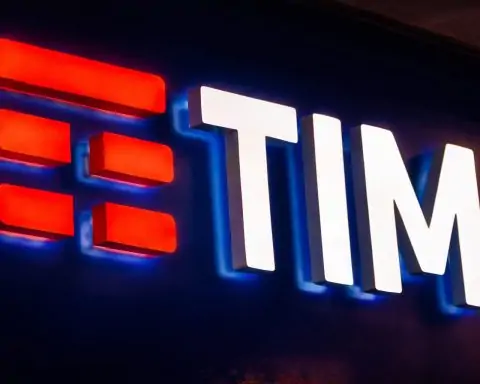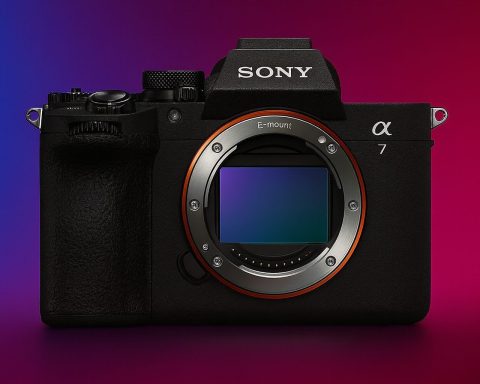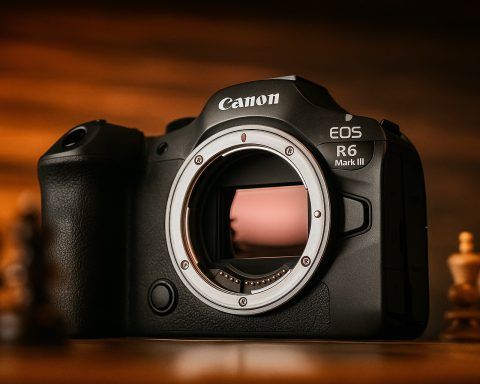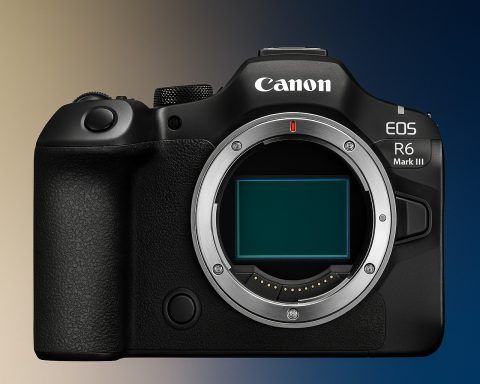- Nikon debuts its first cinema camera: the Nikon ZR, a 24.5MP full-frame “Z Cinema” camera co-designed with RED Digital Cinema, records 6K RAW and carries dual Nikon+RED branding [1] [2]. Priced at ~$2,199, it targets indie filmmakers with pro video features at a mid-range price point [3].
- Canon launches the EOS C50 cine camera (7K/60p full-frame, open-gate 3:2 video) along with a new RF 85mm F1.4 L VCM portrait lens [4] [5]. The C50 is Canon’s smallest cinema EOS (~$3,899) and aims to challenge Sony’s FX3; the 85mm lens offers fast, quiet focus for stills/video [6]. Firmware updates were also announced for Canon’s C400, C80, C70, and R5 C to add C50 features [7].
- Fujifilm unveils its first medium-format cinema camera – the GFX Eterna 55, with a 102MP 44×33mm sensor. It shoots up to 8K large-format video and will ship in Oct 2025 for ~$16,500 [8] [9]. Fuji also introduced a GF 32–90mm T3.5 PZ motorized zoom lens (its first power zoom) for ~$5,996 [10], signaling Fujifilm’s serious entry into “large format” cinema.
- RED’s new V-Raptor XE 8K camera launched at ~$14,995 [11] [12], available in Canon RF or Nikon Z mounts – a rare cross-brand move in high-end cinema [13]. RED calls it an “essential” streamlined version of its flagship, ideal for indie filmmakers who want VV global-shutter 8K imagery without a fully loaded $30K rig [14].
- Lens bonanza:Sigma revealed three new lenses for E/L-mount, including a 20–200mm f/3.5–6.3 10× ultra-zoom (world’s first starting at 20mm) and a groundbreaking 135mm f/1.4 Art – the first autofocus 135mm at f/1.4, dubbed the new “bokeh king” [15] [16]. Samyang and Schneider-Kreuznach teamed up on a 24–60mm f/2.8 Sony E-mount zoom [17], while Leica’s Leitz division launched vintage-look Hektor cine primes with interchangeable mounts (E/L/RF/Z) to cater to the growing demand for characterful glass [18] [19]. Tamron announced a 25–200mm f/2.8-5.6 G2 travel zoom for Sony E (extending its popular 28–200mm by going wider) [20], and third-party maker Viltrox debuted a 56mm f/1.2 Pro lens for Fuji X along with plans for ultra-compact “Air” series lenses – aggressively filling gaps that camera brands haven’t [21] [22].
- Major firmware upgrades rolled out: Sony delivered firmware v7.0/v6.0 for its FX3/FX30 cinema cameras, overhauling the UI and enabling anamorphic 1.5×/1.6× de-squeeze in-camera [23] plus 12-bit Blackmagic RAW output – features “typically reserved for much pricier cine rigs” now free for FX3/FX30 owners [24]. Canon confirmed Q4 firmware adding full-frame 3:2 video and other enhancements to several EOS models [25], and Nikon teased creative updates (a film-grain effect for the retro Zf and future 8K RAW-over-IP streaming via RED modules on the Z8/Z9) [26].
- Industry trends:Prices are climbing – virtually all major brands enacted 2025 price hikes (5–10%) amid inflation and tariffs [27]. Canon warned U.S. tariffs could cost ¥15 billion, costs that will “inevitably pass on to consumers” [28]. Alliances are expanding: Viltrox joined the L-Mount Alliance on Sept 1 (bringing more affordable AF lenses to Leica/Panasonic/Sigma users) [29], and Nikon’s partnership with RED is bearing fruit – the ZR camera features “RED inside” tech and dual logos, a sign Nikon is hungry to innovate and “challenging the established video market” [30] [31]. Mid-sized players are teaming up (Samyang+Schneider, etc.), and even accessory giants like Videndum (Vitec) announced a refocus on high-end cinema gear [32].
Nikon Enters Cinema: ZR with RED DNA
Nikon made waves by announcing the ZR on Sept 10 – its first digital cinema camera and a bold collaboration with RED Digital Cinema. The Nikon ZR is a compact full-frame camera (24.5 MP) capable of internal 6K/60p RAW recording, thanks to a new R3D NE codec co-developed with RED [33]. In fact, the camera carries both Nikon and RED logos on its body, marking the first co-branded product of Nikon’s alliance with RED [34]. By leveraging RED’s renowned color science and codec tech, Nikon is “challenging the established video market” and signaling that this partnership is “bearing fruit,” as observers noted [35] [36]. Priced around $2,199 body-only, the ZR undercuts many rivals (it’s ~$500 cheaper than Nikon’s hybrid Z6 III) and is set to ship by October 20 [37].
Despite its modest cost, the ZR packs pro features to tempt indie filmmakers. It uses the same 24.5MP sensor as the Z6III but in a video-optimized, fanless body with a huge 4-inch, 1000-nit flip-out display instead of an EVF [38]. It supports 12-bit RAW video (Nikon’s N-RAW or RED’s new R3D variant) up to 6K/60, plus 4K/120 and ProRes RAW or other codecs [39] [40]. Notably, it’s the world’s first camera with 32-bit float audio recording on-board, using Nokia’s OZO tech for high-quality capture [41]. With dual base ISOs (800/6400) for 15+ stops dynamic range [42] and 5-axis IBIS (7.5 stops), the ZR is well-equipped for cinematic imagery in a tiny 1.2 lb package [43] [44].
The ZR clearly targets the same crowd eyeing Sony’s FX3/FX30 or Canon’s new C50. Nikon is positioning it as an affordable A-cam or B-cam for creators who want RED-level imaging without a RED camera price. By incorporating RED’s REDCODE RAW format and even adopting RED’s “Exposure Index” approach in its UI, the ZR can slot into existing RED workflows seamlessly [45] [46]. As DPReview noted, “the ZR says Red very prominently on its rear display” and yet retains Nikon’s ergonomic feel in operation [47] [48]. In essence, Nikon has given the Z-mount system a video-focused flagship that blurs the line between mirrorless and cinema camera. Initial hands-on reports praise the ZR’s value – one filmmaker enthused that in-camera RAW, 32-bit audio, IBIS and a 4″ monitor at this price is “incredible… that’s all there is to say really” [49] [50]. Nikon’s bold move, born from its RED partnership (forged after a 2023 patent dispute settlement), shows Nikon’s “hunger” to innovate and pursue new markets [51].
Canon’s Compact Cinema EOS C50 and New RF Portrait Lens
Canon didn’t sit still either – on Sept 9 (just hours before Nikon’s ZR reveal) it pulled back the curtain on the long-rumored EOS C50. Billed as “a compact, full-frame cinema camera” with a brand-new 7K sensor, the C50 is essentially Canon’s answer to Sony’s FX3/FX6 line [52]. It can record 7K/60P in Cinema RAW Light (or oversampled 4K/60p) and notably is Canon’s first camera to offer 3:2 “open-gate” video recording [53]. This means it uses the full sensor area for video, allowing creatives to reframe or use anamorphic lenses with ease – a feature typically found on much higher-end cameras. Canon built the C50 ground-up for video: it has active cooling vents and no mechanical shutter or IBIS (unlike the hybrid EOS R5 C), emphasizing its video-first design and reliability for long shoots [54].
Physically, the EOS C50 is Canon’s smallest cinema EOS ever, weighing ~1.5 lbs and featuring a modular, handheld-friendly form. It has a mini-EVF hump and a detachable top handle unit that adds two full-size XLR audio inputs and extra controls [55] [56] – ideal for documentary or run-and-gun work. Despite the petite size, it offers pro connectivity: an RF lens mount (leveraging Canon’s vast mirrorless lens lineup), dual SD card slots, and support for Canon’s XC remote IP control protocol [57] [58]. Under the hood, the C50’s Dual Base ISO 800/6400 sensor can capture 12-bit RAW and even 32MP stills, making it a true hybrid in capabilities [59] [60]. Canon says it answered the demand for “hyper-mobile” cinema cameras that shooters can take anywhere, from indie film sets to sports and social media video creation [61]. With a price of ~$3,899 (body), the C50 slots below the EOS C70 and C300 series, aiming to compete in the mid-range pro video space (think Blackmagic URSA Mini or Sony FX3) [62] [63]. It’s expected to ship in late Q4 2025 alongside a raft of firmware updates for other Canon cameras.
Canon didn’t stop at the camera. Alongside the C50, it launched a new RF 85mm F1.4 L VCM lens – a premium portrait prime designed to shine for both stills and video. This 85mm f/1.4 is effectively an RF-mount successor to Canon’s beloved EF 85mm f/1.4L, now optimized for mirrorless. It debuts Canon’s “VCM” (Voice Coil Motor) focusing system for faster, quieter autofocus and minimal focus breathing [64]. In practice, that means tack-sharp eye AF and smooth focus pulls without the focus breathing that can plague older lenses. Reviewers note it’s a welcome alternative to Canon’s hefty 85mm f/1.2L – the new f/1.4 is cheaper, lighter, and arguably more versatile for hybrid shooters. Priced at $1,649 and shipping by end of September [65] [66], this lens underscores Canon’s commitment to supporting both its photo and video users with high-end RF glass.
Rounding out Canon’s news, the company also surprised with a throwback PowerShot ELPH 360 HS A – essentially reissuing a 2016 compact camera model to satisfy demand for pocket shooters [67]. The “new” ELPH (available in October for ~$379) is almost identical to the old one except for a switch to microSD storage, but its mere existence shows Canon still sees a niche for inexpensive point-and-shoot cameras [68]. More substantively, Canon detailed firmware updates coming to its existing cinema cameras (EOS C400, C80, C70, and the EOS R5 C). Set for Q4 2025, these updates will trickle down some of the C50’s features – for example, the higher-end EOS C400 will get 3:2 open-gate mode for full-sensor video [69]. Other improvements include better view assist, enhanced focus peaking, more customizable buttons and UI tweaks to improve usability [70]. In Canon’s words, these “bleeding-edge features” show its commitment to keep current cinema EOS users up-to-date [71] [72]. All told, Canon’s 48-hour blitz (camera, lens, firmware, even a compact) signaled a full-court press to maintain its edge in both the photography and cinematography realms.
Fujifilm Goes Big: GFX Eterna 55 Cinema Camera and Power Zoom
In a significant development for medium-format fans, Fujifilm officially unveiled the GFX Eterna 55 – its first-ever large format cinema camera. Announced on Sept 11, this camera had been teased for months, and the final specs confirm it’s a 102 MP, 44×33 mm sensor video powerhouse [73] [74]. Essentially, Fuji took the sensor from its GFX series still cameras (which is ~1.7× larger than full-frame) and adapted it for high-end video production. The GFX Eterna 55 can record up to DCI 8K/30p using the full sensor (“open gate” 4:3 aspect) and up to 4K/60p windowed, among a huge list of resolutions, aspect ratios and codecs supported [75] [76]. In fact, Fujifilm is emphasizing how flexible this camera is – from Super35 crop modes to full 8K, it’s designed to “slide into existing workflows” alongside everything from traditional Super35 cameras up to full-frame 8K rigs [77]. To facilitate that, it supports Apple ProRes 422 HQ/422/LT internally, H.265 10-bit, and outputs 12-bit RAW via HDMI (to an Atomos or similar) [78] [79]. And of course, being a Fujifilm, it boasts an array of 20 Film Simulation modes (like Eterna/Cinema, Velvia, etc.) for out-of-the-box Fujifilm color [80].
The camera’s design is modular and beefy – roughly 110×138×177 mm and 4.4 lb for the body [81]. It features a 5-inch, 2000-nit touchscreen LCD as the main monitor (removable for flexibility) plus a secondary 3-inch display for settings [82]. Fuji has clearly thought about on-set use: the Eterna 55 has a built-in browser-based remote control system over wired/wireless LAN, options for external timecode sync (BNC and even Bluetooth/Atomos AirGlu), and will offer user-loadable 3D LUT support (up to 16 LUTs stored) [83] [84]. It’s a fully-featured cinema brain, not just a “GFX with a fan.” Speaking of which – Fuji hasn’t explicitly listed framerate specs in this snippet, but earlier communications indicated up to 8K/60 may be possible in certain modes, and lower resolutions can go to high FPS for slow-motion. The dynamic range and base ISO performance are expected to be excellent given the huge sensor pixel pitch (and Fuji’s claim of GFX “large format look” in motion).
Fuji’s launch pricing is $16,499.95 for the GFX Eterna 55 body [85] [86], positioning it in line with high-end cameras like RED’s Komodo-X or ARRI’s lower-end offerings – a niche but growing market of “large sensor” digital cinema. Alongside the camera, Fuji introduced a FUJINON GF 32–90mm T3.5 PZ OIS lens, which is notable as Fujifilm’s first motorized power zoom for medium format [87] [88]. This lens (roughly a 25–71mm equivalent in 35mm terms) features optical stabilization and a constant T3.5 aperture, targeted at cinematographers for smooth focal length changes during shots. It’s essentially a bridge between Fuji’s broadcast ENG lenses and its GF photographic lenses. The 32–90mm PZ will cost around $5,996 and should appeal to production studios and drone/vehicle camera users that need remote zoom control on a medium-format rig [89].
The GFX Eterna announcement is a bold move by Fujifilm to carve out a new category. Traditionally, digital cinema has been dominated by Super35 and full-frame sensors; Fuji is betting that some filmmakers will pay a premium for an even larger sensor’s unique look (extra shallow depth of field, high detail, and a different “presence” to the image). Industry experts have been speculating about a “GFX cinema camera” for a while [90], and Fuji delivered, even co-opting the name of its popular Eterna film simulation for the camera’s branding. With the GFX Eterna 55 shipping in October and pre-orders starting Sept 15 [91], we’ll soon see if Hollywood and high-end creators embrace Fuji’s giant sensor vision. At the very least, Fujifilm’s entry validates that large format video is an emerging trend – and it puts Fujifilm into the professional video conversation in a way the company hasn’t been since the analog film days.
RED V-RAPTOR XE: 8K Power in Nikon Z or Canon RF Mount
Meanwhile, RED Digital Cinema made its own splash by launching the V-RAPTOR XE on Sept 9, timed with the IBC show in Amsterdam. The V-Raptor XE is a more affordable, streamlined variant of RED’s top-tier V-Raptor 8K camera – and it’s making headlines for two reasons: price and mount options. Priced at $14,995 (about half the cost of the original V-Raptor), the XE offers the same cutting-edge 8K VV global shutter sensor (40.96×21.60 mm) capable of 8K up to 60 fps (and 4K 120fps, 2K 240fps) [92], but trims some high-end features to reach a wider indie filmmaker market [93] [94]. Notably, RED is selling the V-Raptor XE in a choice of Canon RF mount or Nikon Z mount versions – marking only the second time in RED’s 18-year history that Nikon shooters have a native mount option (the first was a limited Nikon F mount years ago) [95] [96]. This flexibility means the XE can natively use Canon’s RF lenses or Nikon’s Z lenses (as well as any adapted glass for those mounts), without the bulk and expense of PL or EF adapters.
RED’s CEO, Keiji Oishi, emphasized the ethos behind the XE: “ideal for indie filmmakers, documentarians, commercial shooters… who require cinema-grade visuals without the need for every advanced feature in a fully loaded model. As the filmmaking landscape continues to evolve, the V-RAPTOR XE will extend the power of RED even further.” [97] The “XE” moniker stands for “Essentials” – meaning this model curates the core features and leaves out some extras. For instance, the XE has a shorter boot-up time and an upcoming sensor optimization firmware to improve power efficiency [98] [99]. It also forgoes some I/O and expensive add-ons; however, it shares the same sensor and image quality as its big brother. In fact, it boasts 17+ stops of dynamic range and excellent low-light performance, just like the full V-Raptor, and uses the identical REDCODE RAW workflow that high-end productions know [100] [101].
Importantly, RED isn’t locking XE buyers out of upgrades – the company revealed that an XE owner can later send the camera in to be “fully upgraded” to the flagship V-Raptor [X] feature set if needed [102]. The base $14,995 camera is body-only, but RED is also offering a “Cine Essentials” kit at $19,995 that includes a 7″ LCD, electronic ND PL mount adapter, and other accessories to get started [103] [104]. With a weight of just ~4 lbs, the V-Raptor XE is quite compact for an 8K cinema body [105], making it suitable for gimbals, drones, or run-and-gun setups. It’s fully compatible with existing V-Raptor accessories too [106] [107], easing the path for those who may add it as a B-cam to a RED ecosystem.
The significance of RED’s XE launch in this 48-hour window is twofold. First, it underscores the blurring lines between traditionally separate camera domains: here is a true RED cinema camera being offered in mirrorless still-camera mounts (RF, Z) – a nod to the influence of Canon and Nikon even in cinema. Second, it intensifies competition at the ~$15K level, going directly against the likes of ARRI’s Alexa 35 (much pricier), Sony’s FX9 or Venice 6K, and now Fujifilm’s GFX Eterna. With Nikon partnering with RED for the Z-mount variant, it also hints at deeper cooperation (some speculate Nikon might sell a re-badged version or bundle the ZR and V-Raptor Z as a package). Regardless, for cinematographers, the V-Raptor XE means access to RED’s top-tier imaging at a new price point. Pre-orders opened Sept 9 and shipping is expected by October [108] – adding yet another high-end option for filmmakers just as awards season ramps up.
Other Notable Camera & Camcorder Reveals
Beyond the headline-grabbing mirrorless and cine cameras above, the 48-hour period saw a few specialized camera announcements worth noting:
- Panasonic’s Hybrid Broadcast/Cinema Camera: In the lead-up to the IBC broadcast expo (Sept 12–16), Panasonic unveiled the AK-UBX100, a unique 4K camera that combines features of a studio broadcast camera, a cinema-style box camera, and a PTZ (pan-tilt-zoom) remote cam [109]. The UBX100 uses a 2/3″ type 3MOS sensor and a B4 ENG lens mount (standard for broadcast lenses) but breaks new ground as the first broadcast-style camera with fast phase-detect autofocus and AI subject tracking [110]. Traditionally, broadcast cameras rely on manual focus, but Panasonic’s inclusion of PDAF with AI means the camera can auto-track fast-moving subjects – “allowing operators to focus less on technical challenges and more on telling their stories,” in the words of Panasonic product manager Jim Jensen [111]. This could be a game-changer for live sports and events. The boxy UBX100 can operate as a fixed studio camera or even be rigged as a cinema cam, and it supports modern IP streaming protocols (SMPTE 2110, NDI, SRT) out-of-the-box for network production [112]. It’s slated to ship in Q4 2025, and Panasonic hinted that a firmware update will extend the new AF system to a compatible PTZ model by year’s end [113]. The UBX100 demonstrates Panasonic’s strategy to bridge broadcast and cinematic worlds, giving studios one versatile tool for multiple jobs.
- Apple’s iPhone 17 Pro – ProRes RAW in Your Pocket: While not a traditional “camcorder,” Apple’s Sept 9 event introduced the iPhone 17 Pro/Pro Max with camera upgrades aimed squarely at creators and even pros. For the first time ever on a smartphone, Apple enabled ProRes RAW video recording directly in-camera [114]. Using the updated “Final Cut Camera” app, the iPhone 17 Pro can capture full sensor RAW video in Apple’s ProRes RAW codec at up to 4K – essentially turning the phone into a tiny cinema camera. Additionally, Apple announced support for genlock (synchronization) on the iPhone via a new accessory from Blackmagic Design [115]. This allows multiple iPhone 17 Pros to be frame-accurately synced with other pro cameras in multicam shoots – an astonishing feature on a phone. The hardware itself got a boost with a new 200 mm-equivalent periscope telephoto lens (~8× optical zoom) on the Pro Max [116]. Industry commentators noted that Apple is blurring the line between smartphones and dedicated cameras: everyday users now have a device capable of RAW cinematography and integration into professional workflows [117]. While dedicated camera makers aren’t immediately threatened (given sensor size differences), Apple’s moves put pressure on the lower end of the camcorder market and offer a glimpse of an “everyone a filmmaker” future. In other words, a pocketable 8K RAW camcorder from Apple is here, and the traditional camera industry is definitely watching.
- Kodak Charmera & Other Throwbacks: Interestingly, amidst all the high-tech news, Kodak announced a nostalgic point-and-shoot called the Kodak Charmera aimed at reviving the joy of simple photography [118]. Details were sparse in our sources, but it’s a reminder of the mini-trend of retro simplicity. Likewise, a startup named Camp Snap launched the CS-Pro, a $99 screen-less digital camera with vintage vibes (an upgrade to their viral “Camp Snap” kids camera) [119]. These tidbits illustrate that not all innovation is about specs – some is about reimagining the photographic experience for fun and creativity.
Lens Announcements Galore (Sigma, Samyang/Schneider, Leica, Tamron, and more)
Early September 2025 turned into a feast of new lens announcements, with multiple manufacturers unveiling glass for photographers and filmmakers:
- Sigma’s Triple Launch:Sigma dominated the lens headlines on Sept 9 by revealing three new full-frame mirrorless lenses – each targeting a different niche. First is the Sigma 20–200mm f/3.5–6.3 DG Contemporary, an unprecedented 10× zoom ranging from ultra-wide 20mm out to 200mm [120]. This is the world’s first full-frame zoom starting at 20 mm while reaching 200 mm on the long end, essentially a one-lens solution from landscapes to telephoto. Despite the broad range, it’s relatively compact (~550 g) and even offers semi-macro capability (1:2 magnification) at mid zoom [121]. Sigma is pitching it as the ultimate travel lens – notably, at 20 mm it’s significantly wider than typical 24-105 or 24-240 “vacation” zooms, yet it still hits 200 mm for sports or wildlife shots [122]. It’s set to ship in late September for $999 in Sony E and L-Mount (Leica) versions [123] [124]. (No Canon RF version, due to Canon’s closed system – a point of frustration noted by many [125] [126].) Next is the Sigma 35mm f/1.2 DG DN Art (2nd Gen), a revamp of Sigma’s ultra-fast 35mm prime from 2019. The original was loved for its image quality but was big and heavy. The new 35mm f/1.2 Art DG II shrinks size by ~20% and slims weight by ~30% [127]. Sigma achieved this by reducing the filter thread from 82 mm to 72 mm and using new optical materials/designs [128]. Impressively, it still offers the creamy f/1.2 aperture but with improved sharpness and bokeh, and better correction of aberrations like axial CA and coma [129]. Autofocus also gets a boost via dual HLA linear motors in a floating focus system, which speeds AF and dramatically cuts focus breathing – a boon for videographers [130] [131]. Essentially, Sigma listened to feedback and made the 35mm f/1.2 more practical for mirrorless. The new version will cost about $1,549 and also arrives end of September (E-mount and L-mount) [132]. The third lens turned the most heads: the Sigma 135mm f/1.4 DG Art. This is the world’s first 135 mm lens at f/1.4 with autofocus on full-frame [133]. Previously, 135 mm primes typically stopped at f/1.8 (Sigma’s own 135mm f/1.8 Art was a benchmark). Achieving f/1.4 at this focal length required serious optical engineering – the design uses 17 elements (4 FLD low-dispersion and 2 aspherical) to control aberrations and keep the image sharp even wide open [134] [135]. The payoff is a portraiture and low-light monster that Sigma is touting as a new “bokeh king,” delivering incredibly shallow depth of field and subject isolation. At f/1.4 and 135mm, backgrounds can melt away into creamy blur, making subjects “pop” almost in 3D [136]. Despite the large glass, the lens includes an HLA motor for fast AF, a de-clickable aperture ring, and AF-L lock buttons. Build is robust and weather-sealed, per Sigma’s Art series standards. The 135mm f/1.4 Art will launch at $1,899 (E and L mount) in late September [137]. Like its siblings, no RF version was announced – a fact not lost on Canon users (Canon Rumors’ headline wryly noted Sigma announced four new lenses and “none for RF” [138]). Finally, Sigma quietly introduced a bonus product: a 28–45mm T2.0 cinema zoom lens with autofocus, the first in a new “Sigma AF Cine” line [139]. This full-frame cine zoom (in E-mount and L-mount) is priced around $3,399, so it’s more of a specialty item. While it didn’t get as much press, it shows Sigma expanding autofocus into cinema glass – traditionally, cine lenses are manual. All in all, Sigma’s multi-lens launch underlines its commitment to mirrorless systems, especially Sony E and L-mount. In some cases, Sigma is outdoing the camera makers’ own lenses (e.g. no one else has a 20–200 or 135/1.4). Canon RF users, meanwhile, were left watching from the sidelines due to Canon’s third-party AF lens restrictions – a situation Sigma’s CEO has diplomatically lamented as stifling innovation.
- Samyang & Schneider-Kreuznach Team Up: An intriguing East-West collaboration emerged as Samyang Optics (South Korea) and Schneider-Kreuznach (Germany) co-developed a new zoom lens. On Sept 10, the duo announced an AF 24–60mm f/2.8 FE lens for Sony E-mount, to be formally shown at IBC [140] [141]. This follows their first joint product (an AF 14–24mm f/2.8 released earlier in 2025). The new 24–60mm f/2.8 is designed as a compact, “high-performance” standard zoom, offering a constant f/2.8 aperture in a smaller range (most standard 24-70s go to 70mm, but Samyang prioritized portability by stopping at 60mm) [142]. It’s intended to pair with the 14–24 to cover ultra-wide through portrait focal lengths with two lightweight lenses. Early info (via Samyang/SonyAlphaRumors) suggests the optical quality is very high, thanks to Schneider’s design input, and that the lens is well-suited for both stills and video (with minimal breathing and fast AF) [143]. The lens will support front filters (likely 82mm) – interestingly, the prior 14–24mm was lauded as the first 14–24 that allowed screw-on filters [144]. No price was announced yet, but more details are expected once IBC begins. The Samyang-Schneider partnership highlights a trend of cross-continental alliances to compete with bigger brands. Samyang (now rebranded “LK Samyang” after investment from a Korean conglomerate) gains prestige and optical expertise, while Schneider-Kreuznach (famed for cinema and medium-format lenses in decades past) gains a pathway back into the consumer market via autofocus mirrorless lenses. Their first 14–24mm was well received (it “gained strong global recognition” according to Schneider’s Photo/Cine division head) [145] [146], and with the 24–60mm the duo now covers 14mm to 60mm. A telephoto co-design could be next, and this mirrors other partnerships (think Panasonic-Leica or Sony-Zeiss) that leverage each side’s strengths.
- Leica’s Leitz Cinema Lenses (Vintage Reborn): Leica enthusiasts got excited on Sept 10 with news from Wetzlar: Ernst Leitz Cine (Leica’s cinema lens arm) introduced a new line of “Hektor” full-frame cine primes [147]. The Hektor series is named after a classic Leica design from the 1930s, and these new lenses deliberately embrace vintage character. Leitz said it drew inspiration from old Leica stills lenses of the 1930s, 1950s, 1970s – even other manufacturers’ vintage glass – to create lenses with “playfully interesting” optical flaws (flaring, field curvature, spherical aberration) in a modern housing [148] [149]. In short, the Hektors aim to provide a gorgeous, filmic look that is less clinically sharp and more full of character, as many cinematographers today desire for certain projects. The initial set includes six focal lengths: 18mm, 25mm, 35mm, 50mm, 73mm, 100mm – all at T2.1 [150] [151]. They cover full-frame (image circle ~47.8 mm) and notably feature user-interchangeable mounts for L-mount, E-mount, RF, and Z. A shooter could use the same Hektors on a Sony FX3, RED Komodo (RF mount), Leica SL2, or Nikon Z8 by swapping mounts – a huge plus for rental houses and filmmakers with diverse kits [152] [153]. The Hektors are manual focus/iris of course, with cinema-standard build: matched gear positions, ~120° focus throw, robust metal construction (built in Germany like Leitz’s $20K Summilux-C lenses). They even sport a retro silver finish reminiscent of classic Leica screw-mount lenses [154]. Leica hasn’t publicly stated pricing, but speculation is they’ll be pricey (perhaps mid five-figures for a set, rather than six-figures). The key point: Leica (through Leitz Cine) recognizes the trend of “vintage look” lenses and is providing a high-end solution. Filmmakers shooting digital who want flares, glow, and character now have native Leica-made options. It’s also telling that these lenses support mirrorless mounts directly – a nod to how prevalent cameras like the FX3, C70, and others have become even at high-end shoots. With the Hektors, Leica is both honoring its heritage and acknowledging the mirrorless video revolution in filmmaking.
- Tamron and Others (Superzooms & APS-C glass): In addition to the blockbusters above, a few other lens updates emerged:
- Tamron announced development of a 25–200mm f/2.8-5.6 Di III VXD G2 lens on Sept 9 [155]. This is a “G2” successor to Tamron’s popular 28–200mm travel zoom (one of the first full-frame all-in-one zooms with f/2.8 on the wide end). The new version extends the wide end to 25mm, giving a bit more breathing room for tight interiors or landscape vistas [156]. Tamron didn’t detail all specs, but promised optical improvements and faster VXD autofocus. By signaling development now, Tamron likely plans release in early 2026. This shows Tamron doubling down on full-frame Sony E-mount convenience lenses – providing range and speed in one package (still uniquely f/2.8 at 25mm, whereas most superzooms are f/4+). Interestingly, Tamron has also been expanding support to Nikon Z and even Canon RF in some cases. In August, Tamron launched an 18–300mm f/3.5-6.3 for Nikon Z and also Canon RF (APS-C), which was one of the very first third-party AF lenses on RF mount [157]. That RF lens happened via a partnership arrangement with Canon. The new 25–200 G2, however, is only announced for E-mount so far – but it wouldn’t be surprising if Tamron has multi-mount ambitions down the road, given Canon’s recent easing of RF third-party restrictions (slightly).
- Viltrox – beyond joining the L-mount alliance (see Industry section) – kept busy with product launches. In early September, Viltrox released a 56mm f/1.2 Pro lens for Fujifilm X-mount [158]. This offers Fuji shooters an autofocus alternative to Fujifilm’s own XF 56mm f/1.2, and being in Viltrox’s higher-end “Pro” line, it claims improved optics and build quality to satisfy portrait pros. Additionally, Viltrox teased an upcoming “Air” series of ultra-compact lenses: specifically a 9mm f/2.8 (APS-C) pancake and a 14mm f/4 (full-frame) pancake were shown on a roadmap [159]. These tiny lenses emphasize portability – presumably targeted at travel and street photographers or as lightweight video primes for gimbal work. All these moves reinforce how third-party lens makers are aggressively filling gaps in various systems, especially Fuji X (where fast third-party primes are welcome), Nikon Z (which is opening up more), and now L-mount. For consumers, more lens options usually mean better value and niches covered that big brands might ignore.
- Others: The OM System (Olympus) got a mention via a new MFT lens: the company announced a 50–200mm f/2.8 IS Pro lens for Micro Four Thirds (100–400mm full-frame equivalent) – notably one of the fastest long tele zooms ever in MFT, showcasing why “the reason to shoot Micro Four Thirds isn’t the sensor – it’s the lenses” [160]. On the quirky side, 7Artisans launched a $499 2× ultra-macro cine lens, and Kodak (as noted) has some branded lenses popping up via third parties. The lens world, in summary, is buzzing: from exotic ultra-wides (Laowa is teasing a 200mm f/2) to budget primes, September’s news cycle proved that lens innovation is alive and well in 2025.
Firmware Updates Supercharge Existing Cameras
Hardware wasn’t the only source of excitement – several major firmware updates were announced that bring new capabilities to cameras owners already have, blurring the line between old and new gear:
- Sony FX3 & FX30 – Cinema Upgrades: Sony thrilled video shooters by revealing a sweeping firmware update (v7.00 for FX3, v6.00 for FX30) to land in September. These updates effectively supercharge the FX3/FX30 – already popular compact cinema cameras – with features lifted from Sony’s high-end Venice and Burano lines. The headliner is a revamped menu interface with the pro-style “quick access” page (Sony calls it the “Big 6” status screen) that puts critical settings like ISO, frame rate, shutter angle, LUT on one display for fast tweaking [161] [162]. This addresses one of the FX3/FX30’s few criticisms (their consumer-oriented menu system), making them feel more like mini VariCam or Venice cameras in operation. Even bigger, the firmware adds anamorphic de-squeeze options (1.5× and 1.6×) in-camera [163]. Previously, if you mounted an anamorphic lens on an FX3, the camera’s LCD/EVF would show a squeezed image (necessitating an external monitor to desqueeze). After the update, you can select 1.5× or 1.6× and the camera’s live view will stretch the footage to proper Cinemascope proportions [164]. This is a huge boon for indie filmmakers experimenting with anamorphic glass, effectively bringing a high-end monitoring feature down to a sub-$4K camera. Additionally, Sony unlocked 12-bit RAW output over HDMI for both models [165]. Notably, they’ve partnered with Blackmagic Design so that the FX3/30’s RAW can be recorded as Blackmagic RAW (BRAW) on devices like the Blackmagic Video Assist [166]. This is in addition to the existing ProRes RAW support (which required Atomos recorders). By adding BRAW, Sony is acknowledging that many creators edit in DaVinci Resolve and prefer BRAW’s workflow over ProRes RAW. As Newsshooter observed, this essentially gives FX3/FX30 users a budget cinema camera setup – an FX3 plus a recorder can now capture 4K 60p 12-bit RAW video, something unheard of at this price a few years ago [167] [168]. Other improvements include touch-responsive menus, custom LUT workflows, and possibly autofocus or codec refinements (full release notes were expected when the firmware dropped). The camera community widely praised Sony’s move – as one outlet put it, these free updates give the FX3/FX30 features “typically reserved for much pricier cine rigs” [169]. Strategically, it’s also a smart response to new competition (like Canon’s C50 and Nikon’s ZR); Sony is ensuring its existing user base feels their cameras are growing in value, not falling behind. It exemplifies a trend of prolonging the life of camera bodies via firmware – making a 2–3 year old camera suddenly feel new again.
- Canon & Nikon – Firmware News: We’ve already touched on Canon’s planned firmware for its Cinema EOS line (bringing the C50’s open-gate mode and UI tweaks to models like the C400, C70, etc.). To elaborate, Canon specifically noted the EOS C400 will get full-frame 3:2 video recording – an especially notable trickle-down since the C400 is a higher-end camera that predates open-gate, but will now receive that capability via update [170]. Other Canon firmware features include improved View Assist (for more accurate monitoring), better focus peaking, and more programmable buttons on the C80 and C400 [171]. These are slated for Q4 2025 release, likely timed with the C50’s market arrival [172]. It shows Canon leveraging software to keep its pro users happy and maybe dissuade them from eyeing Sony or RED. Nikon, for its part, did not have a major new firmware drop on Sept 10–11, but there were some noteworthy recent updates. On Sept 4, Nikon announced an upcoming firmware for the retro-styled Zf (full-frame mirrorless) that will add a “Film Grain” simulation feature, to further lean into the camera’s analog film vibe [173]. And a few days prior, Nikon had to temporarily disable a new Content Authenticity (CAI) feature in the Z6II/Z7II via firmware due to some bugs, promising a fix later – showing even metadata/authentication tools are on their radar [174]. While minor, these illustrate Nikon adding creative options via firmware (grain simulations, etc.). More interesting was a Nikon-related announcement at IBC: RED Digital Cinema revealed that its RED Connect module will soon enable Nikon Z8 and Z9 cameras to output 8K RAW video live over IP networks [175]. In essence, a Nikon Z9 could serve as an 8K studio camera streaming real-time RED R3D files to a server or cloud. It’s a niche feature (for sports or remote production perhaps), but it underlines the deepening Nikon-RED partnership and the blurring of still and video domains – a DSLR-style body doing multi-cam broadcast duties via firmware/hardware add-ons.
- Blackmagic and DJI Updates: Just outside the 10–11th window, but related, Blackmagic Design released Camera Update 9.0 around IBC. This added support for an upcoming URSA 12K Ⅱ camera and a new OLED EVF, among other improvements. Blackmagic also made a splash days earlier by slashing prices on its high-end URSA Mini Pro 12K models (some by up to $7K) [176], a move possibly aimed at clearing inventory for the new model or simply undercutting RED’s new V-Raptor XE. On the drone front, rumor sites indicated DJI was prepping a firmware update for its Inspire 3 cinema drone to enable Apple ProRes RAW recording internally [177]. Given Apple’s new ProRes RAW push on iPhone and Final Cut, this would make sense – DJI often updates its cameras to support Apple formats. We may see that confirmed soon.
- Software (NLE) Updates: It wasn’t just camera firmware; editing software saw timely updates too. Apple announced that Final Cut Pro (Mac and iPad) will get an update (v11.2) by November to fully support iPhone 17 Pro’s ProRes RAW footage [178]. This includes optimized debayering for the phone’s specific sensor. Similarly, Adobe released updates to Camera RAW/Lightroom around this time, adding improved AI noise reduction profiles for new cameras like the Canon R6 II and Nikon Zf [179]. The broader theme is an increasingly tight integration between capture tech and post-production – with Apple and Blackmagic working with camera makers to ensure new codecs (like ProRes RAW, Blackmagic RAW) and features are supported end-to-end.
In summary, the flurry of firmware news underscores that many advancements in imaging now come via software updates rather than new hardware. Manufacturers are using firmware to extend the life of cameras and to respond quickly to competitors. For users, it’s a boon – waking up to find your camera suddenly does something new (like anamorphic desqueeze or RAW output) is like a free upgrade. It reflects a more mature, software-driven industry, where buying a camera is less about a static feature set and more about an evolving platform that can gain new tricks over time.
Industry Trends, Market Moves, and Expert Insights
The 48-hour period also saw notable business and industry developments in the camera world – from pricing and supply chain shifts to strategic alliances and rumor mill rumblings:
- Rising Prices and Tariff Squeeze: One striking trend in 2025 has been price increases across the board. By early September, virtually all major camera makers – Canon, Nikon, Sony, Fujifilm, Leica, Sigma, etc. – had implemented MSRP hikes on gear in certain regions [180]. For example, Nikon raised U.S. prices on many Z bodies and lenses (some for the second time in a year as of Sept 1) [181]. The culprit is a mix of high inflation, more expensive components, and lingering supply chain issues. On top of that, U.S. import tariffs on Chinese-made photo gear (a holdover from trade wars) continued to bite into margins [182]. Canon’s executives openly warned that these tariffs could cost the company ¥15–16 billion (~$100M), much of which would “inevitably pass on to consumers” [183]. Even brands like Panasonic and OM System (Olympus), which initially ate some costs, signaled they’d likely raise prices by the end of September [184]. For photographers and filmmakers, this means new cameras and lenses launched this fall might be 5–10% pricier than expected a year ago. It also puts pressure on companies to demonstrate value – e.g., Nikon pricing the ZR aggressively at $2,199 was seen as a smart move in a time of tightening budgets [185]. And deals/discounts are fewer as companies guard margins. The takeaway: gear is getting more expensive, so buyers are more discerning (and perhaps holding onto cameras longer, expecting firmware updates to add value).
- Alliances and Partnerships: The industry also saw intriguing cross-company collaborations:
- Viltrox joins L-Mount Alliance: In a notable move, Chinese lens maker Viltrox became an official member of the L-Mount Alliance on Sept 1 [186]. Viltrox is now the 10th member of that club (which includes Leica, Panasonic, Sigma, DJI, Astrodesign, and others). This gives Viltrox full access to the L-mount specs to make native lenses for Leica/Panasonic/Sigma cameras. It’s a win-win: the Alliance gains a manufacturer known for affordable, sharp autofocus lenses (great for consumers), and Viltrox gains an endorsement that could help it sell to higher-end users. Indeed, at the announcement Viltrox immediately teased upcoming L-mount versions of many of its primes and zooms [187]. For the L-mount system (used by Leica SL-series, Panasonic S-series, Sigma fp, etc.), this promises a broader lens ecosystem, addressing one criticism that L-mount lacked third-party options. This move also underlines DJI’s influence – DJI joined the alliance in 2022 and now Viltrox in 2025, showing the alliance is open to new kinds of members (drone and lens specialists alike).
- Nikon & RED – a New Kind of Partnership: The fruits of Nikon’s closer ties with RED were on full display with the ZR launch. Remember, Nikon effectively licensed/acquired some RED technology (after settling a legal dispute in 2023) – and now we see “RED inside” Nikon’s camera [188]. The ZR’s codec is pure RED (R3D RAW), and even its marketing is co-branded. Industry observers are watching this closely. It’s quite unprecedented for a stills camera company to team so closely with a cinema camera company. If this ZR experiment succeeds, Nikon could build out a line of Nikon-RED cine cameras or integrate RED’s color science into future mirrorless models to set them apart. One commentator enthused, “Now we will see the fruits of the RED acquisition… Nikon still sees themselves as the pursuers, and that hunger leads to better innovation.” [189]. In other words, Nikon is using this partnership to differentiate itself from Sony/Canon, and potentially leapfrog in video tech. It’s a bold strategy, and one that could pose a real challenge to the established video players if executed well. Also, RED benefits by getting its codec into more hands (even if indirectly) and possibly selling modules (like the RED Connect) to Nikon users. This alliance is definitely one to watch as the landscape of convergence evolves.
- Third-Party and Cross-brand Collaborations: We already covered Samyang & Schneider teaming up on lenses – a notable cross-continental collaboration. It underscores a trend where medium-sized players join forces to take on giants. We might see more: could Tamron partner with someone to crack Canon RF? (Tamron is partly owned by Sony, so maybe not them.) Or might a company like Tokina align with Fujifilm for medium format lenses? The industry rumor mill is starting to think outside the box, because the old model (everyone doing their own thing) is shifting towards partnerships for mutual gain. Even Kodak has lent its name to lenses and cameras made by third parties in Asia – a branding collaboration of a different sort, aiming at nostalgia.
- Accessory Industry Restructuring: Videndum plc, the UK-based conglomerate formerly known as Vitec Group (owner of Manfrotto, Gitzo, SmallHD, Teradek, JOBY, etc.), announced plans to “refocus” on higher-end professional gear [190]. This likely involves some restructuring and possibly divesting or de-emphasizing cheaper consumer accessories. Videndum signaled it wants to double-down on cinema and broadcasting equipment. For end users, this could mean the likes of Teradek (wireless video systems) and SmallHD (monitors) will get more advanced product development, while some budget-oriented products (like JOBY GorillaPods or lower-end LED lights) might see less attention or even be sold off. It’s a reminder that even in the accessory segment, companies are adjusting strategies amid market changes (smartphones eroding the low end, high-end production gear still in demand). So we may expect faster innovation in pro accessories and possibly fewer entry-level offerings from those brands.
- Market Shake-Ups & Rumors on the Horizon: The news blitz came with a side of speculation about what’s next:
- Panasonic’s Next Move: With Canon and Nikon making big video plays, many are looking to Panasonic to see how it will respond. Panasonic’s Lumix division has been relatively quiet in 2025 (aside from the video-centric S5 IIX earlier). Rumors around Sept 7 hinted that Panasonic teased a new Lumix S series camera – possibly a Lumix S1H Mark II or some kind of “S1H-style” box camera – to be announced in the weeks after IBC [191]. The teaser had a boxy outline, fueling speculation of a larger L-mount video camera or even a camcorder-like form factor. If Panasonic does launch something, it would join an increasingly crowded field of full-frame cine-oriented bodies (now Canon C50, Nikon ZR, Sony FX line). Some wonder if Panasonic might go above the S1H, maybe a true Varicam-style mirrorless, or double down on its strength in dual gain output sensors for dynamic range. Either way, with Panasonic’s reputation among indie filmmakers (thanks to the GH series and S1H), a new offering could be exciting – and necessary to keep Lumix relevant.
- Sony A7S Line Uncertain: A notable whisper via Sony Alpha Rumors claimed that Sony has no plans for an A7S IV and might even discontinue the ‘S’ line of low-light full-frame cameras [192]. The Sony A7S III (12MP low-light beast) was released in 2020 after a long wait, but since then, Sony introduced the FX3 which is essentially an A7S III in a cinema body. The rumor reasons that newer Sony bodies like the A7 IV and A7R V have gotten so good at video (and higher resolution), plus the FX3 covers the 4K 120p niche, that a dedicated A7S IV might be redundant. It’s been 3+ years with no A7S IV announcement, which is unusual. This sparked debate in forums – some videographers feel an A7S IV is still needed (for things like absolutely clean low-light and no overheating), while others think an FX4 or FX3 Mark II will replace it. Sony hasn’t confirmed anything, of course. But if true, the A7S III could be the last of that legendary line, marking the end of an era that started the whole “full-frame mirrorless for video” craze back in 2014. For now, the A7S III remains on sale and very capable. We’ll see in 2026 if Sony surprises with something like an FX6 Mark II or 12K FX8 instead, as some rumors hint.
- Canon EOS R1 on Simmer: The pro photography world is still awaiting Canon’s EOS R1, the expected flagship mirrorless to rival the Nikon Z9 and Sony A1. Canon had initially aimed for “2024 Olympics” with the R1, but that came and went. During early September, no concrete R1 news dropped – however, an interesting tidbit emerged: Canon apparently allowed the founder of Canon Rumors (a popular blog) to test a prototype R1 briefly [193]. This suggests the camera is in an advanced stage. The R1 is rumored to possibly have a high-megapixel global-shutter sensor or other breakthrough tech, but Canon is tight-lipped. Many think an announcement could come in late 2025 or early 2026 in time for events like the UEFA Euro 2026 or even ahead of the 2026 World Cup. In the meantime, Canon seems focused on fleshing out other parts of its lineup (the cinema cameras and perhaps an EOS R7C APS-C cine camera, and even a PowerShot superzoom/vlogging camera that’s rumored for later this month). So R1 watchers must remain patient.
- Medium Format Movements: We saw Fuji’s big entry into medium-format cinema with the GFX Eterna. That aligns with rumblings that “Medium format is the new full-frame” in certain niches. Hasselblad, for instance, has been quiet (after its X2D launch in 2022) – could it answer Fuji in the cine realm or with global shutter tech? Phase One and RED had a collaboration before (the RED 7071X sensor which was essentially medium format). Imaging Resource had suggested Fuji’s move, calling it a “GFX Eterna” rumor [194] – and they were spot on. Now that it’s real, will others follow? Additionally, DJI (which owns a part of Hasselblad) is rumored to be launching a full-frame mirrorless camera (L-mount) on Sept 15 [195]. Leaks point to a DJI “Zenith” camera with a boxy FX3-style design, corner EVF, and Hasselblad color science – effectively DJI leveraging Hasselblad’s expertise to enter the ground camera market [196]. If true, that’s yet another non-traditional player (drone maker) entering the mirrorless camera fray, and with L-mount no less, further heating up competition.
Finally, stepping back, it’s worth observing the overall tone of this whirlwind 48 hours: the camera industry in late 2025 is very much alive and innovating on all fronts. After a few challenging years of pandemic, supply shortages, and stagnation, 2025 has become a rebound year for gear. We’re seeing retro revivals (Nikon Zf Silver, Kodak’s nostalgia cams), truly cutting-edge video tools (Canon C50’s open-gate, Nikon ZR’s RED codec, iPhone’s RAW), bold lens designs (Sigma 135/1.4, Leica Hektors), and unexpected partnerships (Nikon+RED, Samyang+Schneider). As one outlet aptly put, “September 2025 is proving to be a feast for lens lovers and tech enthusiasts”, and this is only the start of the fall product season [197]. With Photokina (the once-mighty photo trade show) long gone, companies are using events like IBC, their own online launches, and strategic leaks to make their big splashes on their own schedule. The takeaway from these two days: photographers and filmmakers have a lot to look forward to – more choices, more capability, and yes, perhaps a bit more cost – but competition is driving every player to up their game. The race to capture image-makers’ hearts (and wallets) is on, and ultimately, we the users stand to benefit from this renaissance in camera tech.
Sources: Canon Newsroom [198] [199]; Nikon Press Release [200] [201]; Red Digital Cinema [202] [203]; Digital Camera World [204] [205]; ts2.tech (Tech News) [206] [207] [208] [209]; DPReview [210] [211]; PetaPixel [212].
References
1. www.dpreview.com, 2. www.nikon.com, 3. ts2.tech, 4. ts2.tech, 5. ts2.tech, 6. ts2.tech, 7. ts2.tech, 8. www.digitalcameraworld.com, 9. www.imaging-resource.com, 10. currently.att.yahoo.com, 11. www.red.com, 12. www.red.com, 13. www.red.com, 14. www.red.com, 15. ts2.tech, 16. ts2.tech, 17. ts2.tech, 18. ts2.tech, 19. ts2.tech, 20. ts2.tech, 21. ts2.tech, 22. ts2.tech, 23. ts2.tech, 24. ts2.tech, 25. ts2.tech, 26. ts2.tech, 27. ts2.tech, 28. ts2.tech, 29. ts2.tech, 30. ts2.tech, 31. ts2.tech, 32. ts2.tech, 33. www.nikon.com, 34. www.dpreview.com, 35. ts2.tech, 36. ts2.tech, 37. ts2.tech, 38. ts2.tech, 39. www.prnewswire.com, 40. www.prnewswire.com, 41. www.nikon.com, 42. www.nikon.com, 43. www.prnewswire.com, 44. www.prnewswire.com, 45. www.dpreview.com, 46. www.dpreview.com, 47. www.dpreview.com, 48. www.dpreview.com, 49. www.dpreview.com, 50. www.dpreview.com, 51. ts2.tech, 52. ts2.tech, 53. ts2.tech, 54. ts2.tech, 55. www.usa.canon.com, 56. www.usa.canon.com, 57. www.usa.canon.com, 58. www.usa.canon.com, 59. www.usa.canon.com, 60. www.usa.canon.com, 61. www.usa.canon.com, 62. ts2.tech, 63. www.usa.canon.com, 64. ts2.tech, 65. www.usa.canon.com, 66. www.usa.canon.com, 67. ts2.tech, 68. ts2.tech, 69. ts2.tech, 70. ts2.tech, 71. ts2.tech, 72. ts2.tech, 73. www.cined.com, 74. www.imaging-resource.com, 75. petapixel.com, 76. petapixel.com, 77. petapixel.com, 78. petapixel.com, 79. petapixel.com, 80. petapixel.com, 81. petapixel.com, 82. petapixel.com, 83. petapixel.com, 84. petapixel.com, 85. petapixel.com, 86. www.digitalcameraworld.com, 87. currently.att.yahoo.com, 88. www.imaging-resource.com, 89. currently.att.yahoo.com, 90. ts2.tech, 91. www.imaging-resource.com, 92. www.red.com, 93. www.red.com, 94. www.red.com, 95. theasc.com, 96. www.cinematography.world, 97. www.red.com, 98. www.red.com, 99. www.red.com, 100. www.red.com, 101. www.red.com, 102. www.red.com, 103. www.red.com, 104. www.red.com, 105. www.red.com, 106. www.red.com, 107. www.red.com, 108. www.red.com, 109. ts2.tech, 110. ts2.tech, 111. ts2.tech, 112. ts2.tech, 113. ts2.tech, 114. ts2.tech, 115. ts2.tech, 116. ts2.tech, 117. ts2.tech, 118. www.digitalcameraworld.com, 119. www.digitalcameraworld.com, 120. ts2.tech, 121. ts2.tech, 122. ts2.tech, 123. ts2.tech, 124. ts2.tech, 125. ts2.tech, 126. ts2.tech, 127. ts2.tech, 128. ts2.tech, 129. ts2.tech, 130. ts2.tech, 131. ts2.tech, 132. ts2.tech, 133. ts2.tech, 134. ts2.tech, 135. ts2.tech, 136. ts2.tech, 137. ts2.tech, 138. ts2.tech, 139. ts2.tech, 140. ts2.tech, 141. ts2.tech, 142. ts2.tech, 143. ts2.tech, 144. ts2.tech, 145. ts2.tech, 146. ts2.tech, 147. ts2.tech, 148. ts2.tech, 149. ts2.tech, 150. ts2.tech, 151. ts2.tech, 152. ts2.tech, 153. ts2.tech, 154. ts2.tech, 155. ts2.tech, 156. ts2.tech, 157. ts2.tech, 158. ts2.tech, 159. ts2.tech, 160. www.digitalcameraworld.com, 161. ts2.tech, 162. ts2.tech, 163. ts2.tech, 164. ts2.tech, 165. ts2.tech, 166. ts2.tech, 167. ts2.tech, 168. ts2.tech, 169. ts2.tech, 170. ts2.tech, 171. www.usa.canon.com, 172. www.usa.canon.com, 173. ts2.tech, 174. ts2.tech, 175. ts2.tech, 176. ts2.tech, 177. ts2.tech, 178. ts2.tech, 179. ts2.tech, 180. ts2.tech, 181. ts2.tech, 182. ts2.tech, 183. ts2.tech, 184. ts2.tech, 185. ts2.tech, 186. ts2.tech, 187. ts2.tech, 188. ts2.tech, 189. ts2.tech, 190. ts2.tech, 191. ts2.tech, 192. ts2.tech, 193. ts2.tech, 194. ts2.tech, 195. ts2.tech, 196. ts2.tech, 197. ts2.tech, 198. www.usa.canon.com, 199. www.usa.canon.com, 200. www.nikon.com, 201. www.nikon.com, 202. www.red.com, 203. www.red.com, 204. www.digitalcameraworld.com, 205. www.digitalcameraworld.com, 206. ts2.tech, 207. ts2.tech, 208. ts2.tech, 209. ts2.tech, 210. www.dpreview.com, 211. www.dpreview.com, 212. petapixel.com










